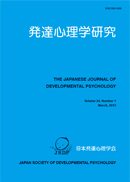Volume 2, Issue 1
Displaying 1-13 of 13 articles from this issue
- |<
- <
- 1
- >
- >|
-
Article type: Article
1991 Volume 2 Issue 1 Pages 1-8
Published: September 20, 1991
Released on J-STAGE: July 13, 2017
Download PDF (881K) -
Article type: Article
1991 Volume 2 Issue 1 Pages 9-16
Published: September 20, 1991
Released on J-STAGE: July 13, 2017
Download PDF (882K) -
Article type: Article
1991 Volume 2 Issue 1 Pages 17-24
Published: September 20, 1991
Released on J-STAGE: July 13, 2017
Download PDF (831K) -
Article type: Article
1991 Volume 2 Issue 1 Pages 25-31
Published: September 20, 1991
Released on J-STAGE: July 13, 2017
Download PDF (795K) -
Article type: Article
1991 Volume 2 Issue 1 Pages 32-40
Published: September 20, 1991
Released on J-STAGE: July 13, 2017
Download PDF (891K) -
Article type: Article
1991 Volume 2 Issue 1 Pages 41-42
Published: September 20, 1991
Released on J-STAGE: July 13, 2017
Download PDF (295K) -
Article type: Article
1991 Volume 2 Issue 1 Pages 42-44
Published: September 20, 1991
Released on J-STAGE: July 13, 2017
Download PDF (430K) -
Article type: Article
1991 Volume 2 Issue 1 Pages 44-46
Published: September 20, 1991
Released on J-STAGE: July 13, 2017
Download PDF (441K) -
Article type: Article
1991 Volume 2 Issue 1 Pages 46-47
Published: September 20, 1991
Released on J-STAGE: July 13, 2017
Download PDF (301K) -
Article type: Article
1991 Volume 2 Issue 1 Pages 48-49
Published: September 20, 1991
Released on J-STAGE: July 13, 2017
Download PDF (299K) -
Article type: Article
1991 Volume 2 Issue 1 Pages 49-51
Published: September 20, 1991
Released on J-STAGE: July 13, 2017
Download PDF (416K) -
Article type: Article
1991 Volume 2 Issue 1 Pages 51-52
Published: September 20, 1991
Released on J-STAGE: July 13, 2017
Download PDF (295K) -
Article type: Article
1991 Volume 2 Issue 1 Pages 52-54
Published: September 20, 1991
Released on J-STAGE: July 13, 2017
Download PDF (363K)
- |<
- <
- 1
- >
- >|
